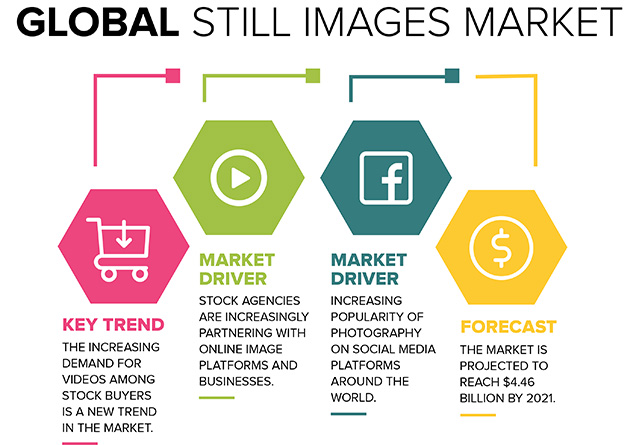Stock photos are professionally-taken photographs of commonplaces, landmarks, nature, events, or people. They can be bought on a royalty-free basis for use in various commercial design applications. These photos are owned either by the photographer or the stock photography distributor, and the designer will often need to adhere to various usage terms, depending on the conditions under which the photo was purchased.
In many cases, stock photos are licensed and may not be re-sold. When used in magazines, for example, there is usually a limit imposed on how many copies of the image are allowed to be printed. Usage policies differ from one provider to the next, so it’s always a good idea to take a closer look at the fine print before making a purchase.
Illustrations, on the other hand, are a more interpretive form of imagery. They are used in a more conceptual approach, to interpret or explain a particular idea. They’re most often used in teaching materials, animations, books, films, video, posters, or similar.
The fantastic thing about illustrations is how flexible they can be. Depending on their purpose, they can be designed to be more technical, expressive, or stylized.

When to Use Stock Photos
Stock photos are often used in a wide range of editorial, commercial, entertainment-related, and artistic applications. They tend to have a marked impact on audiences, who find something relatable in the images. Photographs of people, places, and familiar objects can offer a more realistic slant to the subject matter involved, evoking what could almost be construed as “trustworthiness.”
Stock photos, in short, can catch the eye. They’re real, they’re clear, and they make sense. This is absolutely key in marketing and branding strategies across the board.
Stock photography is typically used in the following commercial applications:
- Marketing &
Advertising - Branding
- Social Media & Online Presence
- Artistic Productions &
Creative Projects (Decoration, etc.) - Corporate Identity
- Business Supporting Material
(Presentations, etc.) - Products for Resale
(T-shirts, Packaging, etc.)
Additionally, stock photography is used in the following editorial applications:
- News coverage: newspapers and magazines articles, broadcast news reports, etc.
- Illustration and accompanying content: articles for magazines, blogs, textbooks, etc.
When to Use Illustrations
Illustrations are often used in a less rigid capacity. Because they can ignore reality to express themes and concepts uniquely, illustrations help to engage the imagination in a way that straight-up photographs do not.
Use illustrations to celebrate an event, breathe new life into a product launch campaign, or to set your audience’s mind at ease when they have a few issues with your product. The great thing about fresh illustrations is that they can be adapted to almost any situation and can even be used as explainers (without having to add too much text).

If you want to explain how a new product works, you can create an infographic that breaks everything down into a step-by-step format. If you have too much text and want to break things up a bit, a well-placed illustration can offer a much-needed break for the reader.
Illustrations are really best applied in situations where you’re trying to convey an abstract thought where a bog-standard photograph simply doesn’t cut it. You can bend and twist illustrations in your own way, really getting your point across in a creative way.
You can really create a definitive brand or personality by using a few cleverly created images when stock photos just won’t do.
Real-life Business Scenarios When You Need Stock Photos and When You Need Illustrations
Not too long ago, businesses leaned towards the trend of using stock photos for all of their marketing collateral – both on and offline. Any businesses who were serious about their branding would purchase tons of these photos online. There was no such thing as a good quality free image. While the landscape has shifted somewhat, it’s still smarter to buy high-quality stock photos to avoid filling websites, flyers, and brochures with overused images.
Businesses make use of stock photos for the following key reasons:
- Depicting something more literal
Photographs are grounded in reality. When selling a physical product, it may be best to choose stock photos that accurately reflect that product. - Portraying competence and professionalism
If you’re a larger corporation that is trying to avoid seeming too provocative or surreal, you’ll want to make use of photographs where you can. This is particularly true in industries related to air travel and corporate security, among others. - Save time and money
Stock photos, when compared to custom photography, are an affordable way to add visual content. You don’t need to book a photographer, set up a shoot, and wait weeks for the editing process to be complete.
It may not always be clear from the onset whether stock photos or illustrations are the better choices. Each comes with its own set of pros and cons. Quite obviously, the resources, cost, and time involved in creating illustrations are vastly different to downloading a few quick stock photographs.
Below are some of the top reasons to use illustrations:
- Expressing an abstract idea
When no specific visuals seem to be useful, illustrations are the way to go.
- Photographing the subject is too difficult
When it’s highly impractical to photograph a particular subject, whether because of financial or logistical constraints, it’s best to let your imagination do the work instead. - Storytelling is your main aim
If a compelling narrative is your end goal, well-executed illustrations can help to carry across your brand’s identity and purpose. It’s a great way to really showcase your business’ personality. - You need to visualize important data
There’s a reason infographic is so popular. No one really wants to sift through pages and pages of data – that’s fairly self-explanatory. If you want your audience to absorb information fast, some informative illustrations are a smart choice.
Find Good Quality, Licensed Stock Images and Use Them to Your Advantage
To create an effective design, it’s not enough to simply rely on the stock images themselves. To get the best out of your desired stock photos and stock images, you need to ensure that your searches are tailored enough and that you pay attention to the following:
- Bold and bright color schemes
- Using icons to illustrate specific concepts
- Visualizations should be paired with accurate data from charts and infographics
- Making sure that you create text that works well with your graphics on social media
- Use pre-made social media templates for a professional look
Some of the best places to find amazing stock imagery include the following:

If you’re concerned about using images that are too “run-of-the-mill,” it’s worth looking at some professional illustration agencies. These agencies represent talented artists from around the world who work for them on a commission basis.
Below are a few of the most popular agencies:
- GraphicMama
- Design Garden
- Truly Design Studio
Illustrations Give a More Personalized Touch
Illustrations are a powerful artistic tool that can give your digital marketing efforts the boost they need. They give you the opportunity to create a website and marketing collateral that are truly unique. When possible, it’s a good idea to work closely with a professional illustrator to ensure that your vision is accurately reflected in the artwork. Where your brand is concerned, you want to make sure that you cover all your basis. Your business deserves quality imagery that is original, inspiring and can stand the test of time. Contact Artwork Abode for your graphic design or illustration needs.
-ArtworkAbode



